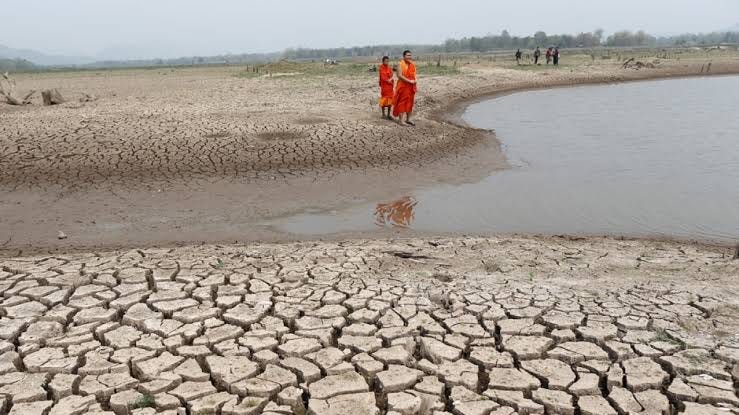Collapsed Croplands, drought, disasters: possible implications after hottest Day ever Recorded
The past offers no comfort
Drought in Thailand, Credit, Al Jazeera
In Australia, between 2006 and 2007, the wheat harvest collapsed, as severe drought and heat waves led to great losses in crop harvests, consigning many farmers and others into a situation of economic quagmire.
Heat waves in 2018 led to multiple crop failures and the loss of yields of up to fifty percent in northern and central Europe, which experienced a severe drought across fifty-two percent of the cropland area.
And in China, heat waves and drought also led to economic trouble in the Liaoning Province, as they led to 20-25 percent reductions in maize harvest in 2014, with more than two million hectares of crops affected.
Heat waves and droughts always lead to multiple crop failures and losses of yields in huge percentages, and with the present heat waves pushing up the mercury from China to North Africa and the southern states of the U.S., the global average temperatures reaching 17.18 degrees Celsius, the heat looks likely to lead to negative impacts on global food security in the short and long term.
Obviously, crops benefit from rising temperatures and carbon dioxide emissions, but when they happen through great increases in the average global temperature, especially when such crops act like wheat, great challenges occur.
One study estimates that when crops live through an increase of one degree Celsius in global mean temperatures, they experience a six percent reduction in wheat yields, with rice witnessing a 3.2 percent decrease, while maize could experience a 7.4 percent fall in the production of the crop.
In still another study, temperature and carbon dioxide emissions affect crops such as maize and soybean when they exist within an increase at elevated levels, as 20 percent of the positive impact of temperatures to soybean production could be lost, while the benefit to wheat could be slashed by 52 percent.
Therefore, crop yields always suffer through increases in one or two degrees Celsius, and with the earth recording one of the hottest days on July 4 due to a dangerous combination of the climate change and the return of the El Nino pattern, food security in the near future could be compromised, if the world continues its business-as-usual approach to cutting its emissions of greenhouse gases.
Due to the drought and heat waves in Kenya, more than two million people needed to survive around 2016, the drought affecting 23 of the nation's 47 counties, the price of maize dropping by a third in one year, while the production of the crop plunged.
At about the same period in India, millions of people needed to survive the drought and heat waves that occurred around them, as serious food and drinking security concerns led to challenges in places such as Andhra, Pradesh, Karnataka, Maharashtra, and Uttar Pradesh.
An unprecedented drought swept over tropical South America in 2016, when the heat waves extended over the southern parts of the continent during the summer of 2017-2018.
Millions of people needed to recover from the worst drought in decades over portions of Argentina and Uruguay, with the losses from the event estimated to be about $3.9 billion, the most expensive disaster in the history of both Uruguay and Argentina.
Many people needed to recover during the 2015-2016 El Nino-induced drought crisis in southern Africa, when the heat waves swept through Madagascar, Zambia, South Africa, and Mozambique, which saw over 40 percent of its crops lost, and farmers losing more than $600 million through fire in five of South Africa's nine provinces.
At climate change-induced heat waves, such as the one that led the world to record its hottest day in 125,000 years this month, many people would need to recover from the food crisis caused by the temperature rises of one or two degrees Celsius, because they always lead to multiple crop failures and the loss of yields in huge percentages, pushing humans into avoidable disasters.
It all boils down to fossil fuel emissions. It boils down to cutting down on fuel emissions. It boils down to reducing the amount of fuel emissions. If fuel emissions could be reduced, it won't boiled down to people having to suffer from the consequences of the heat about to be unleashed as a result of climate change and the El Nino pattern going forwards.
Five Surging Topics in Renewable Energy Sector
Solar Energy, Credit, Britannica
The renewable energy sector is experiencing significant growth and surging in various parts of the world. Here are some of the trends and factors that are contributing to the surge in renewable energy sectors.
Solar Power: Solar energy is one of the fastest-growing renewable energy sources. Falling solar panel prices, advancements in technology, and supportive government policies were driving the adoption of solar power for residential, commercial, and utility-scale applications.
Wind Power: Wind energy is another prominent player in the renewable energy landscape. Onshore and offshore wind farms were being constructed at an impressive rate, providing clean electricity to numerous regions.
Energy Storage: The development of cost-effective energy storage solutions, such as batteries, is a crucial factor in promoting the growth of renewable energy. These storage systems allowed for better grid integration and helped balance the intermittent nature of renewable sources.
Policy Support: Many governments were implementing supportive policies and financial incentives to encourage the adoption of renewable energy. These policies included feed-in tariffs, tax credits, and renewable energy tariffs
Technological Advancements: Ongoing research and development in the renewable energy sector were resulting in more efficient and cost-effective technologies, making renewable energy increasingly competitive with traditional fossil fuels.
What to Eat
Vegan diet in Thailand, Credit, Connoisseurus Veg







Sorry to skip straight to the food portion, but I want Thai food now!